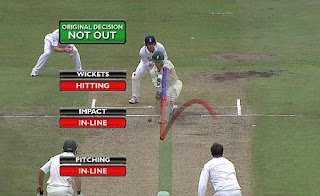I was at the beach. Two guys came and settled down nearby with a pack of masala groundnuts. One of them seemed upset at how things had turned out for India in the cricket Test match against Australia. The other guy had a know-all look about him.
Small time player: Do we really need DRS?
Officer: Why not, we have the technology. On-field umpires need all the help they can get.
P: Then why doesn't the umpire himself consult the third umpire for LBW etc.?
O: He isn't allowed to, except for a few decisions e.g. run out, clean catch etc.
P: He is responsible for his decision, isn't he?
O: hmmm...
P: Why should the team be docked for the umpire's decision... I mean reducing the number of reviews if their appeal for review is turned down.
O: Because you can't repeatedly question the umpire's decision... time is wasted and you know time is money.
P: Isn't DRS about getting better decisions?
O: Of course, that's why they spend around US$100,000 on it for a Test match.
P: How many credible appeals are made in 80 overs, or in a day, roughly?
O: I don't know... could be 20-30 on a wicket that produces a result.
P: And a team gets only two chances if the two reviews are unsuccessful?
O: Yes, the teams have to get their decisions right.
P: Isn't that why we have umpires?
O: hmmm...
P: I think you should let the umpires get help from the DRS umpire on their own. To limit the time taken, you could give the umpires and the teams one review every 10 overs.
O: Sure, I'll inform ICC if they ask me.
Officer had emptied the groundnuts and got up for a refill.

